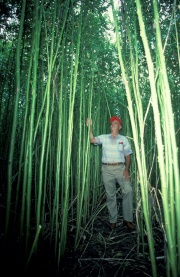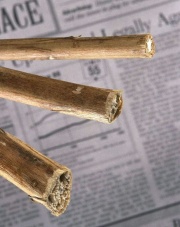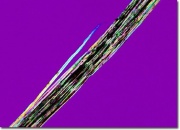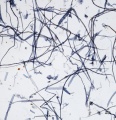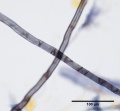Difference between revisions of "Kenaf"
| Line 1: | Line 1: | ||
[[File:kenafplantsf5.jpg|thumb|Kenaf ''Hibiscus cannabis'']] | [[File:kenafplantsf5.jpg|thumb|Kenaf ''Hibiscus cannabis'']] | ||
== Description == | == Description == | ||
| − | + | [[File:Kenaff5.jpg|thumb|Dried kenaf stems]] | |
Bast fibers obtained from the stems of the fast-growing ''Hibiscus cannabinus'' plant. The plant is found throughout the world and the fibers have a wide variety of names: It is called paco-paco in South America; Java jute in Indonesia; and Billipatam jute, sunee, brown Indian hemp, Deccan hemp in India. Kenaf fibers were introduced to Europe in the late 18th century, but did not become widely used until the 20th century. Kenaf is a light colored fiber that is resistant to water. It is similar to jute and was used as a substitute during World War II. Kenaf is still used in burlap coffee bags and for ropes and cords. The woody core of the plant is used in paper products and particleboard. The oil from kenaf seeds is used for lamps. | Bast fibers obtained from the stems of the fast-growing ''Hibiscus cannabinus'' plant. The plant is found throughout the world and the fibers have a wide variety of names: It is called paco-paco in South America; Java jute in Indonesia; and Billipatam jute, sunee, brown Indian hemp, Deccan hemp in India. Kenaf fibers were introduced to Europe in the late 18th century, but did not become widely used until the 20th century. Kenaf is a light colored fiber that is resistant to water. It is similar to jute and was used as a substitute during World War II. Kenaf is still used in burlap coffee bags and for ropes and cords. The woody core of the plant is used in paper products and particleboard. The oil from kenaf seeds is used for lamps. | ||
| + | [[File:kenafbastlarge.jpg|thumb|Kenaf fiber]] | ||
| − | |||
== Synonyms and Related Terms == | == Synonyms and Related Terms == | ||
| Line 10: | Line 10: | ||
== Physical and Chemical Properties == | == Physical and Chemical Properties == | ||
| − | |||
| − | |||
| − | Paper fiber type: non-woody/bast. Using transmitted light microscopy, fibers appear long, flat and thin. Faint dislocations, variable ends and lumens can also be seen. Vessels are profuse if whole plant is pulped. Appearance with [[Graff "C" stain]]: grey-blue. Average dimensions of fibers: length 5mm, width 21μm. Common pulping method: | + | * Plant height = 1.5-3.5 m with woody base |
| + | * Stems=1-2 cm in diameter. | ||
| + | * Leaves=lobed (10-15 cm long) | ||
| + | * Fruit = capsule (2 cm) containing several seeds | ||
| + | * Fiber cross section = polygonal | ||
| + | |||
| + | Paper fiber type: non-woody/bast. Using transmitted light microscopy, fibers appear long, flat and thin. Faint dislocations, variable ends and lumens can also be seen. Vessels are profuse if whole plant is pulped. Appearance with [[Graff "C" stain]]: grey-blue. Average dimensions of fibers: length 5mm, width 21μm. Common pulping method: retting. | ||
==Additional Images== | ==Additional Images== | ||
<gallery> | <gallery> | ||
| − | Kenaf 10x.jpg|Kenaf paper pulp stained with Graff "C" stain | + | Kenaf 10x.jpg|Kenaf paper pulp stained with Graff "C" stain at 10x |
| − | Kenaf 40x fibers3.jpg|Kenaf paper pulp stained with Graff "C" stain | + | Kenaf 40x fibers3.jpg|Kenaf paper pulp stained with Graff "C" stain at 40x |
</gallery> | </gallery> | ||
| Line 37: | Line 41: | ||
* Wikipedia: http://en.wikipedia.org/wiki/Kenaf (Accessed Nov. 9, 2005) | * Wikipedia: http://en.wikipedia.org/wiki/Kenaf (Accessed Nov. 9, 2005) | ||
| − | * | + | * Olympus Microscopy Resource Center at http://www.olympusmicro.com/galleries/polarizedlight/pages/kenafbastsmall.html - introduced to Europe in the late 1700s |
* G.S.Brady, ''Materials Handbook'', McGraw-Hill Book Co., New York, 1971 Comment: p. 427; Hibiscus sabdariffa | * G.S.Brady, ''Materials Handbook'', McGraw-Hill Book Co., New York, 1971 Comment: p. 427; Hibiscus sabdariffa | ||
| Line 45: | Line 49: | ||
* Random House, ''Webster's Encyclopedic Unabridged Dictionary of the English Language'', Grammercy Book, New York, 1997 Comment: H. cannabinus | * Random House, ''Webster's Encyclopedic Unabridged Dictionary of the English Language'', Grammercy Book, New York, 1997 Comment: H. cannabinus | ||
| − | * Art and Architecture Thesaurus Online, | + | * Art and Architecture Thesaurus Online, https://www.getty.edu/research/tools/vocabulary/aat/, J. Paul Getty Trust, Los Angeles, 2000 |
* Marja-Sisko Ilvessalo-Pfäffli. ''Fiber Atlas: Identification of Papermaking Fibers'' (Springer Series in Wood Science). Springer, 1995. | * Marja-Sisko Ilvessalo-Pfäffli. ''Fiber Atlas: Identification of Papermaking Fibers'' (Springer Series in Wood Science). Springer, 1995. | ||
Revision as of 12:21, 22 September 2022
Description
Bast fibers obtained from the stems of the fast-growing Hibiscus cannabinus plant. The plant is found throughout the world and the fibers have a wide variety of names: It is called paco-paco in South America; Java jute in Indonesia; and Billipatam jute, sunee, brown Indian hemp, Deccan hemp in India. Kenaf fibers were introduced to Europe in the late 18th century, but did not become widely used until the 20th century. Kenaf is a light colored fiber that is resistant to water. It is similar to jute and was used as a substitute during World War II. Kenaf is still used in burlap coffee bags and for ropes and cords. The woody core of the plant is used in paper products and particleboard. The oil from kenaf seeds is used for lamps.
Synonyms and Related Terms
Hibiscus cannabus; mesta (India); meshta; Guinea hemp; Deccan hemp (India); Java jute (Indonesia); paco-paco (South America); ambary hemp; ambari hemp; awasthe hemp; bimli patam; bimli jute (India); gambo hemp; gombo hemp; Billipatam jute (India); sunee (India); brown Indian hemp (India); kenaf (Esp.); kenaf= javajute, deccanhennep (levert juteachtige vezel) (Ned);
Physical and Chemical Properties
- Plant height = 1.5-3.5 m with woody base
- Stems=1-2 cm in diameter.
- Leaves=lobed (10-15 cm long)
- Fruit = capsule (2 cm) containing several seeds
- Fiber cross section = polygonal
Paper fiber type: non-woody/bast. Using transmitted light microscopy, fibers appear long, flat and thin. Faint dislocations, variable ends and lumens can also be seen. Vessels are profuse if whole plant is pulped. Appearance with Graff "C" stain: grey-blue. Average dimensions of fibers: length 5mm, width 21μm. Common pulping method: retting.
Additional Images
Comparisons
Resources and Citations
- J.Gordon Cook, Handbook of Textile Fibres:I Natural Fibres, Merrow Publishing Co. , Durham, England, 1984 Comment: H. cannabinus
- Fairchild's Dictionary of Textiles, Phyllis G.Tortora, Robert S. Merkel (eds.), Fairchild Publications, New York City, 7th edition, 1996 Comment: H. cannabinus
- Marjory L. Joseph, Introductory Textile Science, Holt, Rinehart and Winston, Fort Worth, TX, 1986
- Encyclopedia Britannica, http://www.britannica.com Comment: "Kenaf." Accepted. 2 Sept. 2004. H. cannabinus
- Wikipedia: http://en.wikipedia.org/wiki/Kenaf (Accessed Nov. 9, 2005)
- Olympus Microscopy Resource Center at http://www.olympusmicro.com/galleries/polarizedlight/pages/kenafbastsmall.html - introduced to Europe in the late 1700s
- G.S.Brady, Materials Handbook, McGraw-Hill Book Co., New York, 1971 Comment: p. 427; Hibiscus sabdariffa
- Richard S. Lewis, Hawley's Condensed Chemical Dictionary, Van Nostrand Reinhold, New York, 10th ed., 1993
- Random House, Webster's Encyclopedic Unabridged Dictionary of the English Language, Grammercy Book, New York, 1997 Comment: H. cannabinus
- Art and Architecture Thesaurus Online, https://www.getty.edu/research/tools/vocabulary/aat/, J. Paul Getty Trust, Los Angeles, 2000
- Marja-Sisko Ilvessalo-Pfäffli. Fiber Atlas: Identification of Papermaking Fibers (Springer Series in Wood Science). Springer, 1995.
- Walter Rantanen. "Fiber ID Course." Integrated Paper Services. June 2013. Lecture.
